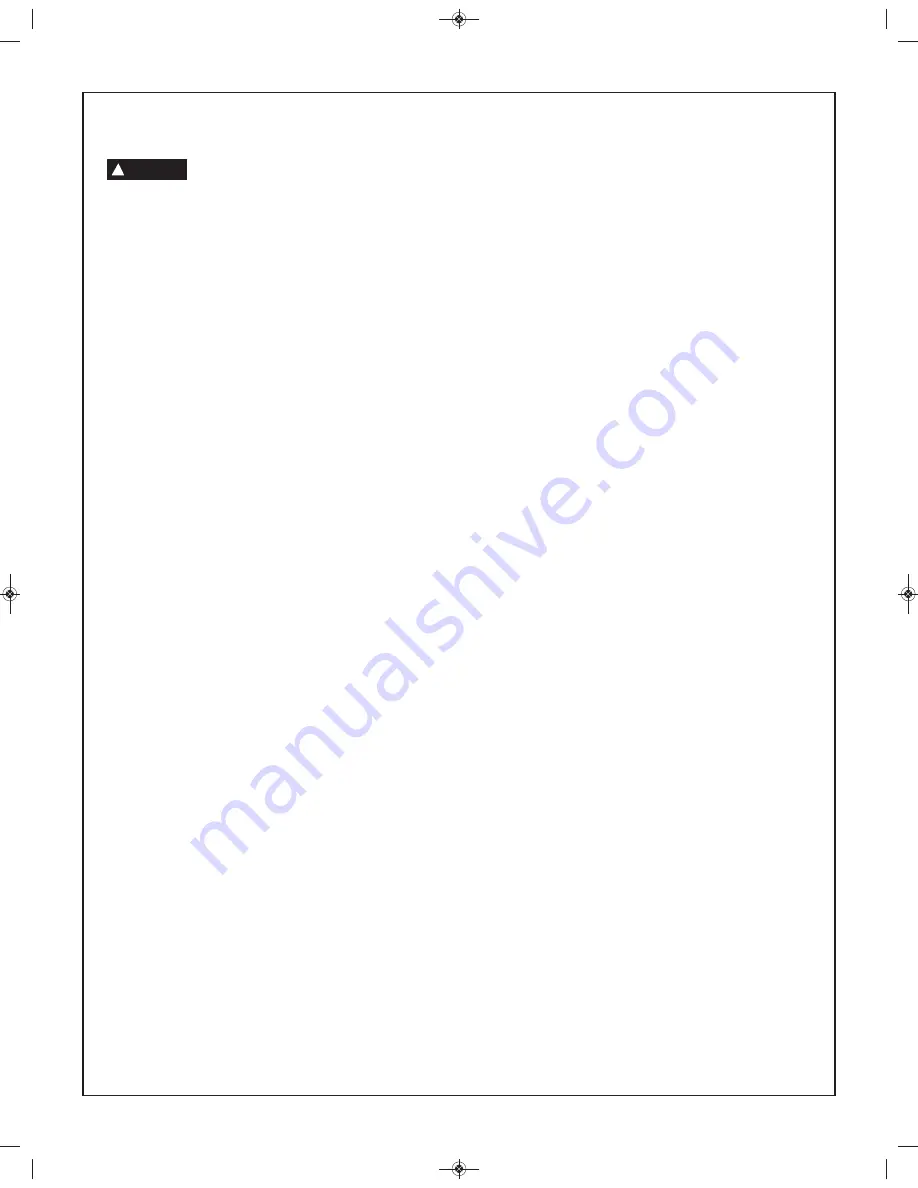
2.
General Pneumatic Tool Safety Rules
ALL USERS AND EMPLOYERS/OWNERS MUST READ AND UNDERSTAND ALL INSTRUCTIONS IN THIS
MANUAL BEFORE OPERATING OR MAINTAINING THIS TOOL.
Failure to follow all instructions listed below
may result in electric shock, fire, serious personal injury or death.
SAVE THESE INSTRUCTIONS
Work Area
Keep your work area clean and well lit.
Cluttered
benches and dark areas increase the risks of accidents,
electric shock, fire, and injury to persons.
Do not operate pneumatic tools in explosive
atmospheres, such as in the presence of flammable
liquids, gases, or dust.
The tool is able to create sparks
which may ignite the dust or fumes. Never use the tool in
sites containing lacquer, paint, benzine, thinner, gasoline,
gases, adhesive agents, and other materials which are
combustible or explosive.
Keep bystanders, children, and visitors away while
operating a pneumatic tool.
Distractions may cause loss
of control of the tool. Fragments of fasteners may cause
injury to bystanders.
Never engage in horseplay with the tool.
Respect the
tool as a working implement.
Personal Safety
Do not remove, tamper with, or otherwise cause the tool
operating controls to become disabled or inoperable.
This will cause the tool to work irregularly and may result in
the risk of injury.
Dress properly. Do not wear loose clothing or jewelry.
Contain long hair. Keep your hair, clothing, and gloves
away from moving parts.
Loose clothes, jewelry, or long
hair can be caught in moving parts and increases the risk of
injury.
Always wear eye and ear protection when using this
tool. Use additional personal protective equipment as
appropriate when operating this tool.
Operators and
others in work area must wear safety glasses with side
shields and make sure all other personnel in the work area
wear safety glasses. Safety glasses must conform to the
requirements of American National Standards Institute,
ANSI Z87.1 and provide protection against flying particles
both from the front and side. Prolonged exposure to high
intensity noise is able to cause hearing loss. Dust mask,
non-skid safety shoes, hard hat and other personal
protective equipment, must be used for appropriate
conditions.
Keep handles dry, clean and free from oil and grease.
Slippery hands cannot safely control the tool.
Avoid directing exhaust air from the tool into your or a
bystander face and eyes.
Exhaust air from a tool can
contain water, oil, metal particles or contaminants from the
compressor, which can be blown into the eyes or cause
serious injury. Use adjustable air vent to direct exhaust to
blow exhaust air away from user.
Stay alert. Watch what you are doing, and use common
sense when operating a pneumatic tool. Do not use the
tool while tired or under the influence of drugs, alcohol,
or medication.
A moment of inattention while operating the
tool may result in serious personal injury.
Avoid unintentional operation. While connecting air
supply do not depress trigger.
Do not carry the tool with
your finger on the trigger or connect the tool to the air
supply with the switch “on.”
Do not overreach. Keep proper footing and balance at
all times.
Proper footing and balance enable better control
of the tool in unexpected situations.
Make sure air hose is free of snags and obstructions.
Do not attach an air hose or tool to your body.
Entangled or snarled hoses can cause a loss of balance or
footing in addition to unintentional tool operation. Attach the
hose to the structure to reduce the risk of loss of balance if
the hose shifts.
Tool Use and Care
Use this tool and accessories in accordance with the
instructions.
Tools and accessories must be used for the
purpose for which they are designed. Use of the pneumatic
tool for operations different from what's described in this
manual can result in a hazardous situation.
Use only accessories that are recommended by BOSCH
for your particular model.
Accessories that may be
recommended for a particular model tool may not be
suitable on other model tools and may result in personal
injury.
Before each use, inspect the tool. Do not operate if any
portion of the tool is loose, missing, damaged,
malfunctioning, disconnected or altered.
If the tool
appears to be operating unusually and/or making strange
noises, stop using it immediately and contact your local
service center. There is a risk of bursting if the tool is
damaged.
Do not force tool. Use the correct tool for your
application.
The correct tool will do the job better and safer
at the rate for which it is designed.
Do not operate the tool with any power source other
than that specified in the tool operating/safety
instructions.
Use of alternative power sources may result
in malfunctions of the tool and the power source which may
lead to serious injury of you or others in your surroundings.
Disconnect tool from air supply when not in use.
Leaving the tool unattended with the air supply connected
can result in unintentional operation of the tool by users
unfamiliar with tool.
!
WARNING
BM 2610957377 02-09:BM FNA250 06-09 6/17/09 8:00 AM Page 2



































